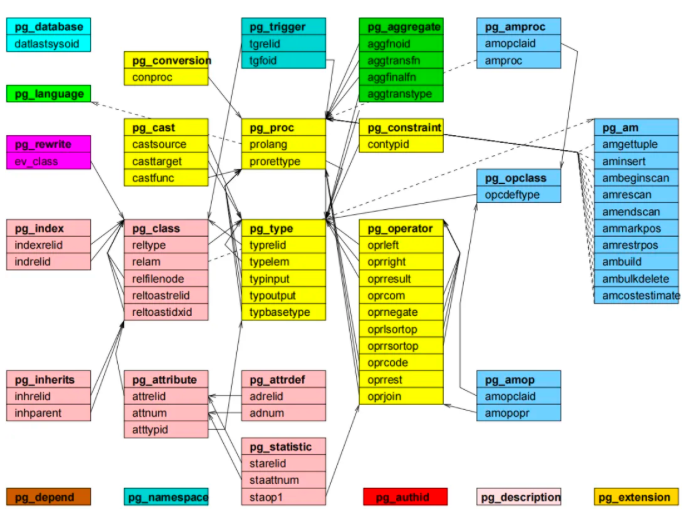本期内容如下:
- 系统表间的外键关联
- 连接符和IS NOT NULL的优先级
- 函数出参规范命名
- MogDB在B模式下使用自定义变量
- SQL挑战赛第二期PG 16解法
1.如何查询系统表之间的关联信息

普通表的外键关联信息可以通过系统表pg_constraint进行查询,典型查询语句如下:
SELECT conname, conrelid::pg_catalog.regclass AS ontable,
pg_catalog.pg_get_constraintdef(oid, true) AS condef
FROM pg_catalog.pg_constraint c
WHERE confrelid = 'a'::pg_catalog.regclass
AND contype = 'f'
ORDER BY conname;
复制但系统表之间的关联并没有使用显式的主外键关联,需要使用系统函数pg_get_catalog_foreign_keys()进行获取:
SELECT *
FROM pg_get_catalog_foreign_keys()
WHERE pktable = 'pg_authid'::regclass;
复制例如,PG内部使用比较频繁的pg_authid系统表,它与哪些系统表之间有关联关系呢?
postgres=# SELECT *
FROM pg_get_catalog_foreign_keys()
WHERE pktable = 'pg_authid'::regclass;
┌─────────────────────────┬──────────────┬───────────┬────────┬──────────┬────────┐
│ fktable │ fkcols │ pktable │ pkcols │ is_array │ is_opt │
├─────────────────────────┼──────────────┼───────────┼────────┼──────────┼────────┤
│ pg_proc │ {proowner} │ pg_authid │ {oid} │ f │ f │
│ pg_type │ {typowner} │ pg_authid │ {oid} │ f │ f │
│ pg_class │ {relowner} │ pg_authid │ {oid} │ f │ f │
│ pg_operator │ {oprowner} │ pg_authid │ {oid} │ f │ f │
│ pg_opfamily │ {opfowner} │ pg_authid │ {oid} │ f │ f │
│ pg_opclass │ {opcowner} │ pg_authid │ {oid} │ f │ f │
│ pg_language │ {lanowner} │ pg_authid │ {oid} │ f │ f │
│ pg_largeobject_metadata │ {lomowner} │ pg_authid │ {oid} │ f │ f │
│ pg_statistic_ext │ {stxowner} │ pg_authid │ {oid} │ f │ f │
│ pg_event_trigger │ {evtowner} │ pg_authid │ {oid} │ f │ f │
│ pg_namespace │ {nspowner} │ pg_authid │ {oid} │ f │ f │
│ pg_conversion │ {conowner} │ pg_authid │ {oid} │ f │ f │
│ pg_database │ {datdba} │ pg_authid │ {oid} │ f │ f │
│ pg_db_role_setting │ {setrole} │ pg_authid │ {oid} │ f │ t │
│ pg_tablespace │ {spcowner} │ pg_authid │ {oid} │ f │ f │
│ pg_auth_members │ {roleid} │ pg_authid │ {oid} │ f │ f │
│ pg_auth_members │ {member} │ pg_authid │ {oid} │ f │ f │
│ pg_auth_members │ {grantor} │ pg_authid │ {oid} │ f │ f │
│ pg_ts_config │ {cfgowner} │ pg_authid │ {oid} │ f │ f │
│ pg_ts_dict │ {dictowner} │ pg_authid │ {oid} │ f │ f │
│ pg_extension │ {extowner} │ pg_authid │ {oid} │ f │ f │
│ pg_foreign_data_wrapper │ {fdwowner} │ pg_authid │ {oid} │ f │ f │
│ pg_foreign_server │ {srvowner} │ pg_authid │ {oid} │ f │ f │
│ pg_user_mapping │ {umuser} │ pg_authid │ {oid} │ f │ t │
│ pg_policy │ {polroles} │ pg_authid │ {oid} │ t │ t │
│ pg_default_acl │ {defaclrole} │ pg_authid │ {oid} │ f │ f │
│ pg_collation │ {collowner} │ pg_authid │ {oid} │ f │ f │
│ pg_publication │ {pubowner} │ pg_authid │ {oid} │ f │ f │
│ pg_subscription │ {subowner} │ pg_authid │ {oid} │ f │ f │
└─────────────────────────┴──────────────┴───────────┴────────┴──────────┴────────┘
(29 rows)
复制2.连接符||和IS NOT NULL的优先级
查询语句如下:
SELECT case when t.a||'' is not null then 1 else 2 end res
FROM (SELECT 'a'::varchar AS a ) t;
复制- PostgreSQL 9.5之前,语句执行的逻辑是t.a||(’’ is not null)
- PostgreSQL 9.5开始,语句执行的逻辑是(t.a||’’) is not null
PostgreSQL 9.5以上的版本,上面的语句可以正常执行,9.5之前会报错如下:
ERROR: argument of CASE/WHEN must be type boolean, not type text
LINE 1: SELECT case when t.a||'' is not null then 1 else 2 end res
^
复制3.函数出参规范命名问题
相关表结构如下:
drop table if exists t1,t2;
create table t1(id int,type varchar);
create table t2(id int,flag varchar);
insert into t1 values(1,'pg');
insert into t2 values(1,'abc');
复制下面的查询语句字段的引用比较清晰,type和flag不存在重名需要加别名的因素。
select a.id,type,flag
from t1 a inner join t2 b using(id);
复制但如果查询语句通过函数返回时,函数的出参名称可能会影响字段是否需要加别名。
例如下面函数的出参名称直接使用查询语句返回的字段名:
create or replace function f_get_list()
returns table(id int,type varchar,flag varchar)
as $$
begin
return query select a.id,type,flag
from t1 a
inner join t2 b using(id);
end;
$$ LANGUAGE plpgsql;
复制此时查询函数会报错
select * from f_get_list();
复制错误如下:
ERROR: column reference "type" is ambiguous LINE 1: select a.id,type,flag复制
该问题有两种解法:
- 查询语句返回的所有字段都显式带别名
return query select a.id,a.type,b.flag from t1 a inner join t2 b using(id);复制
- 函数return参数使用新名称,例如统一加前缀
returns table(v_id int,v_type varchar,v_flag varchar)复制
无论哪种处理习惯都可避免这个错误。
4.MogDB在MySQL兼容性模式下如何使用自定义用户变量
MySQL兼容性下,使用虚拟行号,类似Oracle的rownum,示例如下
SET @rownum := 0;
SELECT id, @rownum := @rownum + 1 AS rn FROM (values('a'),('b'),('c')) t(id) ;
复制使用@设置自定义变量,需要先开启enable_set_variable_b_format参数为on
SET enable_set_variable_b_format TO on;
复制5.SQL挑战赛第二期(墨天轮)
参考链接:https://www.modb.pro/db/1826549073320697856
尝试使用PG 16的any_value特性
WITH cte_group_flag(seqno,amount,group_flag) AS
(
SELECT seqno,amount,count(amount) over (order by seqno) group_flag
FROM test_gen
),cte_group_amount(group_flag,amount_all) AS
(
SELECT group_flag,any_value(amount) amount_all
FROM cte_group_flag
GROUP BY group_flag
)
SELECT seqno,amount,amount_all
FROM cte_group_flag
LEFT JOIN cte_group_amount USING (group_flag)
;
复制本文结束~
往期回顾
- 数据库微观案例第48期
- 数据库微观案例第47期
- 数据库微观案例第46期
- 数据库微观案例第45期
- 数据库微观案例第44期
- 数据库微观案例第43期
- 数据库微观案例第42期
- 数据库微观案例第41期 |NULL值案例
- 数据库微观案例第40期
- PostgreSQL智慧碎片|微观案例 |宏观收获
- PostgreSQL小案例集|4月刊
与我联系
- 微信公众号:象楚之行
- 墨天轮:https://www.modb.pro/u/15675
- 微信:skypkmoon
勤耕细作,用心积微;静待花开,量变质成。
「喜欢这篇文章,您的关注和赞赏是给作者最好的鼓励」
关注作者
【版权声明】本文为墨天轮用户原创内容,转载时必须标注文章的来源(墨天轮),文章链接,文章作者等基本信息,否则作者和墨天轮有权追究责任。如果您发现墨天轮中有涉嫌抄袭或者侵权的内容,欢迎发送邮件至:contact@modb.pro进行举报,并提供相关证据,一经查实,墨天轮将立刻删除相关内容。
评论
勤耕细作,用心积微;静待花开,量变质成。
6月前
 点赞
点赞 评论
相关阅读
2025年3月中国数据库排行榜:PolarDB夺魁傲群雄,GoldenDB晋位入三强
墨天轮编辑部
1969次阅读
2025-03-11 17:13:58
【专家有话说第五期】在不同年龄段,DBA应该怎样规划自己的职业发展?
墨天轮编辑部
1322次阅读
2025-03-13 11:40:53
【专家观点】罗敏:从理论到真实SQL,感受DeepSeek如何做性能优化
墨天轮编辑部
1308次阅读
2025-03-06 16:45:38
DeepSeek R1助力,腾讯AI代码助手解锁音乐创作新
若城
1186次阅读
2025-03-05 09:05:00
06 HarmonyOS Next性能优化之LazyForEach 列表渲染基础与实现详解 (一)
若城
1145次阅读
2025-03-05 21:09:40
09 HarmonyOS NEXT 仿uv-ui Tag组件开发教程系列(三)
若城
1061次阅读
2025-03-06 22:06:10
08 HarmonyOS NEXT 仿uv-ui Tag组件开发教程系列(二)
若城
1059次阅读
2025-03-06 21:37:02
11 【HarmonyOS NEXT】 仿uv-ui组件开发之Avatar组件深度剖析(二)
若城
1056次阅读
2025-03-07 21:35:16
10 【HarmonyOS NEXT】 仿uv-ui组件开发之Avatar头像组件开发教程(一)
若城
1056次阅读
2025-03-07 21:10:59
07 HarmonyOS NEXT 仿uv-ui Tag组件开发教程系列(一)
若城
1049次阅读
2025-03-06 21:03:19







